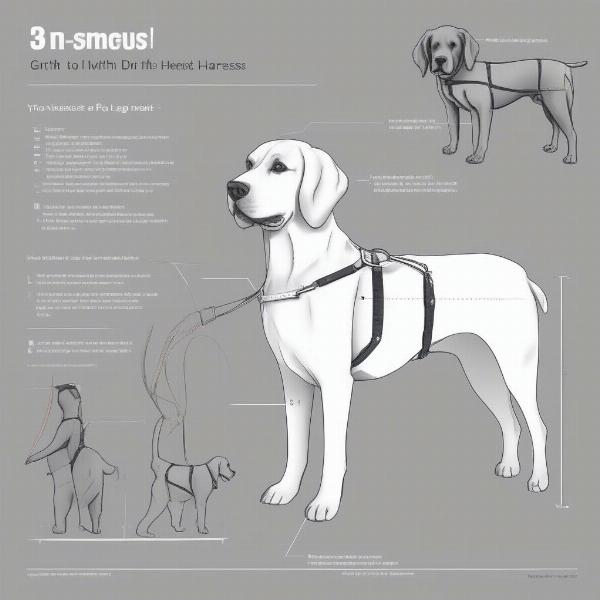Choosing the right harness for your extra-large dog can be a challenge. A properly fitted XL dog harness ensures both comfort and control, allowing you to enjoy walks and adventures with your furry friend. This guide will cover everything you need to know about finding the perfect XL dog harness, from understanding different types to considering specific needs and ensuring a perfect fit.
Types of XL Dog Harnesses
There are various types of harnesses available, each designed for specific purposes and dog breeds. For larger dogs, certain styles are often preferred due to their strength and control.
-
Back-Clip Harnesses: These are a common type, featuring a clip on the back for leash attachment. While suitable for well-trained dogs, they may not offer enough control for strong pullers.
-
Front-Clip Harnesses: These harnesses feature a leash attachment point at the front of the chest, providing more control over pulling. They can be particularly helpful for training.
-
Dual-Clip Harnesses: These harnesses offer both front and back clip options for maximum versatility. This allows you to adapt to different situations and training needs.
-
No-Pull Harnesses: Designed specifically for dogs who pull, these harnesses often have a front clip and may include additional features like tight straps around the chest to discourage pulling.
-
Vest Harnesses: These harnesses offer more coverage and padding, providing extra comfort and support, particularly beneficial for older dogs or those with sensitive skin.
Choosing the Right XL Dog Harness: Factors to Consider
Selecting the best harness involves considering several factors specific to your dog.
-
Breed and Size: Certain breeds have different chest and body shapes, so consider breed-specific recommendations. Accurate measurements are crucial for a proper fit.
-
Activity Level: For highly active dogs, a durable and secure harness designed for sports or outdoor adventures is essential.
-
Training Needs: If you’re working on leash training, a front-clip or no-pull harness can be beneficial.
-
Health Conditions: Older dogs or those with joint issues may benefit from a supportive vest harness.
-
Weather Conditions: Consider harnesses made from breathable materials for warmer climates.
 Properly Fitting an XL Dog Harness
Properly Fitting an XL Dog Harness
Measuring Your Dog for an XL Harness
A proper fit is crucial for comfort and effectiveness. Use a soft tape measure and follow these steps:
-
Girth: Measure around the widest part of your dog’s chest, behind the front legs.
-
Neck: Measure around the base of your dog’s neck, where the collar usually sits.
-
Length: Measure from the base of the neck to the base of the tail.
Use these measurements to consult the sizing chart for the specific harness you are considering. A snug but not restrictive fit is ideal.
Caring for Your XL Dog Harness
Proper care will extend the life of your harness. Most harnesses can be hand-washed or machine-washed on a gentle cycle. Air drying is recommended.
What if my dog pulls even with a no-pull harness?
Sometimes, even with a no-pull harness, a dog might still pull. This could be due to incorrect fit or underlying behavioral issues. Consult a professional dog trainer for personalized guidance.
Conclusion
Finding the perfect XL dog harness is an important investment in your dog’s comfort and safety. By considering your dog’s individual needs and taking accurate measurements, you can ensure a perfect fit for enjoyable walks and a stronger bond with your furry companion.
FAQ
- What is the best type of harness for a large dog who pulls? A front-clip or no-pull harness is often recommended for strong pullers.
- How often should I clean my dog’s harness? Cleaning frequency depends on usage, but generally every few weeks is a good guideline.
- Can I leave my dog’s harness on all the time? It’s generally not recommended to leave a harness on all the time, as it can cause skin irritation or matting.
- What should I do if my dog’s harness rubs or chafes? Check the fit and adjust if necessary. Consider a harness with more padding.
- How do I know if my dog’s harness is too small? If the harness is digging into the skin or restricting movement, it’s likely too small.
- Are there any breed-specific harness recommendations? Yes, some harnesses are designed with specific breeds in mind. Consult breed-specific resources for guidance.
- What materials are best for dog harnesses? Durable and breathable materials like nylon or padded mesh are generally good choices.
ILM Dog is your trusted resource for expert dog care advice. We offer a comprehensive range of resources covering breed selection, health, training, nutrition, grooming, and much more. Whether you’re a first-time dog owner or a seasoned expert, ILM Dog is here to help you navigate every aspect of dog ownership. Contact us at [email protected] or +44 20-3965-8624 for personalized support.